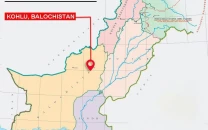PMD warns of intense heatwave
NDMA flags storm risks; mercury to spike by end of April

As the sun beat down mercilessly across most parts of the country on Friday, the Pakistan Meteorological Department (PMD) sounded the alarm, issuing a heatwave alert with temperatures expected to soar from April 26 to 30.
The sweltering spell, driven by a high-pressure system settling in the upper atmosphere, will likely turn up the heat nationwide.
The weather system is expected to develop on April 26 and grip most parts of the country by April 27, causing a spike in daytime temperatures.
Day temperatures are predicted to remain 5-7 °c above normal in the southern regions, including Sindh, southern Punjab and Balochistan, from April 26 to May 1.
Meanwhile, areas in the upper half of the country-central and upper Punjab, Islamabad, Khyber Pakhtunkhwa, Kashmir and Gilgit-Baltistan are expected to experience temperatures 4-6 C above normal from April 27 to April 30.
Relief is expected from May 1, as a new weather system may bring rain, thunderstorms and hailstorms to parts of Kashmir, Islamabad, the Pothohar region, northeast Punjab, upper Khyber Pakhtunkhwa and Gilgit-Baltistan beginning April 30.
The general public, especially children, women and the elderly, are advised to avoid direct sunlight during the day and stay well-hydrated to prevent heat-related illnesses.
Farmers should plan their wheat harvesting activities accordingly and take measures to protect their livestock. Rising temperatures in the northern areas could also accelerate the snowmelt rate, particularly between April 27 and May 1.
The citizens are urged to use water wisely across all sectors. Furthermore, strong winds, dust storms, and lightning may pose risks to structures such as electric poles, trees, vehicles and solar panels on April 30 and May 1.
The authorities have been advised to stay alert and take all necessary precautions to minimise the risks associated with the heatwave.
The National Disaster Management Authority (NDMA) had issued a warning on Friday, forecasting unstable weather conditions across several regions of Pakistan from May 1 to 7.
According to the NDMA's National Emergency Operations Centre (NEOC), heavy rainfall, windstorms, thunderstorms, lightning, and isolated hailstorms were expected in Khyber Pakhtunkhwa, Gilgit-Baltistan, Azad Jammu and Kashmir (AJK), Upper and Central Punjab, northern Balochistan and southern Sindh.
The NDMA had attributed the adverse weather to moisture influx from eastern regions and the Arabian Sea, coupled with rising temperatures and humidity. The authority had cautioned that low-lying areas in the affected regions could face waterlogging, while hilly areas were at risk of landslides.
Authorities had advised relevant departments and the public to remain vigilant and take necessary precautions. The NDMA had also urged citizens to stay updated through the Pak NDMA Disaster Alert App for real-time weather alerts and advisories, particularly before travelling.
The disaster management body had assured that it was closely monitoring the situation through NEOC in coordination with provincial and district authorities to ensure a prompt response and public safety.
Citizens were reminded to follow official guidelines to minimise risks during the severe weather spell. (With Input from APP)



















COMMENTS
Comments are moderated and generally will be posted if they are on-topic and not abusive.
For more information, please see our Comments FAQ